Integrated Sensing and Communication via Orthogonal Time Frequency Space Signaling with Hybrid Message Passing Detection and Fractional Parameter Estimation
Abstract
:1. Introduction
- Channel Characteristics: OTFS modulation is explicitly designed to handle time-varying channels, making it well suited to high-mobility scenarios. It excels in scenarios with rapid changes in the channel, such as vehicular communication or high-speed rail.
- Mobility and Doppler Tolerance: OTFS modulation is designed to handle scenarios with high Doppler shifts. Its DD domain representation naturally separates signals, enabling effective mitigation of Doppler effects.
- Multipath Handling: OTFS modulation excels in multipath environments due to its ability to separate signals in the DD domain, providing superior performance in challenging propagation conditions. OTFS modulation may have an increased computational complexity compared to OFDM.
- Accuracy in Time-Varying Channels: OTFS modulation excels in accuracy in time-varying channels, offering robust communication and sensing capabilities in high-mobility environments.
- Multipath Fading and Time Variability
- (a)
- Performance Improvement: OTFS modulation is particularly well suited to environments with severe multipath fading. By transforming the received signals from the time-delay domain to the DD domain, OTFS modulation can effectively separate multipath components. This transformation enhances the system’s ability to combat fading and improves communication performance.
- (b)
- Resilience to Time Variability: OTFS modulation is designed to handle time-varying channels, making it robust in scenarios where the channel conditions change rapidly. This is crucial in dynamic environments, such as those encountered in vehicular communication or mobile communication, where the channel characteristics can vary over short time intervals.
- Interference Rejection
- (a)
- Spatial Separation: The DD domain representation in OTFSs provides a form of spatial separation for different signals. This can aid in the rejection of interference, as signals from different directions in the DD domain can be more easily distinguished.
- (b)
- Improved Detection in Noisy Environments: The ability of OTFS modulation to focus on distinct DD signatures allows for improved detection in the presence of interference and noise. The framework’s capacity to isolate signals in the DD domain contributes to enhanced interference rejection capabilities.
2. System Model
2.1. Introduction of OTFS Modulation
- Computational Complexity: The OTFS framework involves complex mathematical transformations, including the conversion from the time-delay domain to the DD domain. These operations can be computationally intensive, especially in real-time applications or resource-constrained environments.
- Channel Estimation and Tracking: Accurate channel estimation and tracking are crucial for the success of the OTFS framework. In dynamic environments with rapidly changing channel conditions, developing robust algorithms for real-time channel estimation and tracking becomes a challenge.
- Synchronization: Achieving precise synchronization is essential for accurate transformation between domains in the OTFS framework. Synchronization challenges may arise in scenarios with high mobility, multipath propagation, and varying signal delays.
- Adaptability to Non-Ideal Conditions: Real-world environments often introduce non-ideal conditions such as frequency-selective fading, non-line-of-sight (NLOS) scenarios, and interference. The OTFS framework needs to be adaptable to such conditions, requiring advanced signal processing techniques and algorithms.
2.2. DD Domain Input–Output Relationship in OTFS Modulation
3. OTFS-Based Radar Sensing
3.1. Two-Dimensional Matched-Filter Operation
3.2. GLRT-Based Target Detection
3.3. Fractional Parameter Estimation
4. Hybrid Message Passing Detector
5. Results
6. Discussion
7. Conclusions
Author Contributions
Funding
Institutional Review Board Statement
Informed Consent Statement
Data Availability Statement
Conflicts of Interest
References
- Cui, Y.; Nie, J.; Yu, T.; Zou, J.; Yuan, W.; Jing, Z.; Mu, J.; Jing, X. Sensing-Assisted Communication Beamforming Based on Multi-Modal Feature Extraction for High-Reliable IoV. In Proceedings of the 3rd ACM MobiCom Workshop on Integrated Sensing and Communications Systems, Madrid, Spain, 6 October 2023; pp. 19–24. [Google Scholar]
- Mu, J.; Ouyang, W.; Hong, T.; Yuan, W.; Cui, Y.; Jing, Z. Digital Twin-enabled Federated Learning in Mobile Networks: From the Perspective of Communication-assisted Sensing. IEEE J. Sel. Areas Commun. 2023, 41, 3230–3241. [Google Scholar] [CrossRef]
- Yuan, W.; Du, Z.; Meng, X.; Liu, F.; Masouros, C. Integrated Sensing and Communication for Vehicular Networks. In Integrated Sensing and Communications; Liu, F., Masouros, C., Eldar, Y.C., Eds.; Springer Nature: Singapore, 2023; pp. 419–444. [Google Scholar]
- Wu, J.; Yuan, W.; Liu, F.; Cui, Y.; Meng, X.; Huang, H. UAV-based target tracking: Integrating sensing into communication signals. In Proceedings of the 2022 IEEE/CIC International Conference on Communications in China (ICCC Workshops), Sanshui, China, 11–13 August 2022; pp. 309–313. [Google Scholar]
- Zhou, D.; Guo, J.; Wang, S.; Zheng, Z.; Fei, Z.; Yuan, W.; Wang, X. OTFS-based Robust MMSE Precoding Design in Over-the-air Computation. arXiv 2023, arXiv:2307.01525. [Google Scholar]
- Wu, J.; Yuan, W.; Hanzo, L. When UAVs Meet ISAC: Real-Time Trajectory Design for Secure Communications. arXiv 2023, arXiv:2306.14140. [Google Scholar] [CrossRef]
- Zhang, Y.; Li, B.; Wu, N.; Ma, Y.; Yuan, W.; Hanzo, L. Message Passing-Aided Joint Data Detection and Estimation of Nonlinear Satellite Channels. IEEE Trans. Veh. Technol. 2022, 72, 1763–1774. [Google Scholar] [CrossRef]
- Zhang, X.; Yuan, W.; Liu, C. Deep Residual Learning for OTFS Channel Estimation with Arbitrary Noise. In Proceedings of the 2022 IEEE/CIC International Conference on Communications in China (ICCC Workshops), Sanshui, China, 11–13 August 2022; pp. 320–324. [Google Scholar]
- Li, S.; Wei, Z.; Yuan, W.; Yuan, J.; Bai, B.; Ng, D.W.K. On the achievable rates of uplink NOMA with asynchronized transmission. In Proceedings of the 2021 IEEE Wireless Communications and Networking Conference (WCNC), Nanjing, China, 29 March–1 April 2021; pp. 1–7. [Google Scholar]
- Chong, R.; Li, S.; Yuan, W.; Yuan, J. Outage analysis for OTFS-based single user and multi-user transmissions. In Proceedings of the 2022 IEEE International Conference on Communications Workshops (ICC Workshops), Seoul, Republic of Korea, 16–20 May 2022; pp. 746–751. [Google Scholar]
- Li, S.; Yuan, W.; Yuan, J.; Caire, G. On the potential of spatially-spread orthogonal time frequency space modulation for ISAC transmissions. In Proceedings of the ICASSP 2022—2022 IEEE International Conference on Acoustics, Speech and Signal Processing (ICASSP), Singapore, 23–27 May 2022; pp. 8722–8726. [Google Scholar]
- Li, S.; Yuan, W.; Liu, C.; Wei, Z.; Yuan, J.; Bai, B.; Ng, D.W.K. A Novel ISAC Transmission Framework based on Spatially-Spread Orthogonal Time Frequency Space Modulation. IEEE J. Sel. Areas Commun. 2022, 40, 1854–1872. [Google Scholar] [CrossRef]
- Wei, Z.; Yuan, W.; Li, S.; Yuan, J.; Bharatula, G.; Hadani, R.; Hanzo, L. Orthogonal Time-Frequency Space Modulation: A Promising Next-Generation Waveform. IEEE Wirel. Commun. 2021, 28, 136–144. [Google Scholar] [CrossRef]
- Zhang, K.; Li, Z.; Yuan, W.; Cai, Y.; Gao, F. Radar Sensing via OTFS Signaling. arXiv 2023, arXiv:2306.11223. [Google Scholar] [CrossRef]
- Shi, Q.; Wu, N.; Wang, H.; Yuan, W. Joint channel estimation and decoding in the presence of phase noise over time-selective flat-fading channels. IET Commun. 2016, 10, 577–585. [Google Scholar] [CrossRef]
- Yuan, W.; Wu, N.; Wang, H.; Kuang, J. Distributed passive localization with asynchronous receivers based on expectation maximization. In Proceedings of the 2015 IEEE Global Communications Conference (GLOBECOM), San Diego, CA, USA, 6–10 December 2015; pp. 1–6. [Google Scholar]
- Li, S.; Yuan, J.; Fitzpatrick, P.; Sakurai, T.; Caire, G. Delay-Doppler domain Tomlinson-Harashima precoding for OTFS-based downlink MU-MIMO transmissions: Linear complexity implementation and scaling law analysis. IEEE Trans. Commun. 2023, 71, 2153–2169. [Google Scholar] [CrossRef]
- Yuan, W.; Wu, N.; Wang, H.; Kuang, J. Factor graph approach for joint passive localization and receiver synchronization in wireless sensor networks. In Proceedings of the 2016 IEEE 27th Annual International Symposium on Personal, Indoor, and Mobile Radio Communications (PIMRC), Valencia, Spain, 4–8 September 2016; pp. 1–5. [Google Scholar]
- Li, Z.; Yuan, W.; Zhou, L. UAMP-based channel estimation for OTFS in the presence of the fractional doppler with HMM prior. In Proceedings of the 2022 IEEE/CIC International Conference on Communications in China (ICCC Workshops), Sanshui, China, 11–13 August 2022; pp. 304–308. [Google Scholar]
- Yuan, W.; Wu, N.; Wang, H.; Li, B.; Kuang, J. Variational message passing for joint localization and synchronization in wireless sensor networks. In Proceedings of the 2014 IEEE/CIC International Conference on Communications in China (ICCC), Shanghai, China, 13–15 October 2014; pp. 437–441. [Google Scholar]
- Liu, C.; Yuan, W.; Li, S.; Liu, X.; Ng, D.W.K.; Li, Y. Predictive beamforming for integrated sensing and communication in vehicular networks: A deep learning approach. In Proceedings of the ICC 2022-IEEE International Conference on Communications, Seoul, Republic of Korea, 16–20 May 2022; pp. 1948–1954. [Google Scholar]
- Wen, H.; Yuan, W.; Li, S. Downlink OTFS non-orthogonal multiple access receiver design based on cross-domain detection. In Proceedings of the 2022 IEEE International Conference on Communications Workshops (ICC Workshops), Seoul, Republic of Korea, 16–20 May 2022; pp. 928–933. [Google Scholar]
- Wu, N.; Zhang, Y.; Ma, Y.; Li, B.; Yuan, W. Vector approximate message passing based iterative receiver for OTFS system. In Proceedings of the 2021 IEEE/CIC International Conference on Communications in China (ICCC Workshops), Xiamen, China, 28–30 July 2021; pp. 422–426. [Google Scholar]
- Li, S.; Yuan, J.; Yuan, W.; Wei, Z.; Bai, B.; Ng, D.W.K. On the performance of coded OTFS modulation over high-mobility channels. In Proceedings of the 2021 IEEE International Conference on Communications Workshops (ICC Workshops), Montreal, QC, Canada, 14–23 June 2021; pp. 1–6. [Google Scholar]
- Wang, Z.; Han, K.; Jiang, J.; Liu, F.; Yuan, W. Multi-vehicle tracking and id association based on integrated sensing and communication signaling. IEEE Wirel. Commun. Lett. 2022, 11, 1960–1964. [Google Scholar] [CrossRef]
- Zhang, X.; Yuan, W.; Liu, C.; Liu, F.; Wen, M. Deep Learning with a Self-Adaptive Threshold for OTFS Channel Estimation. In Proceedings of the 2022 International Symposium on Wireless Communication Systems (ISWCS), Hangzhou, China, 19–22 October 2022; pp. 1–5. [Google Scholar]
- Surabhi, G.; Augustine, R.M.; Chockalingam, A. Peak-to-average power ratio of OTFS modulation. IEEE Commun. Lett. 2019, 23, 999–1002. [Google Scholar] [CrossRef]
- Yuan, W.; Hao, G.; Wu, N.; Wang, H.; Kuang, J. Passive localization with inaccurate receivers based on Gaussian belief propagation on factor graph. In Proceedings of the 2014 IEEE/CIC International Conference on Communications in China (ICCC), Shanghai, China, 13–15 October 2014; pp. 453–457. [Google Scholar]
- Yuan, W.; Shi, Q.; Wu, N.; Guo, Q.; Huang, X. Gaussian message passing based passive localization in the presence of receiver detection failures. In Proceedings of the 2018 IEEE 87th Vehicular Technology Conference (VTC Spring), Porto, Portugal, 3–6 June 2018; pp. 1–5. [Google Scholar]
- Yuan, W.; Wu, N.; Wang, H.; Li, B.; Kuang, J. Joint synchronization and localization based on Gaussian belief propagation in sensor networks. In Proceedings of the 2015 IEEE International Conference on Communications (ICC), London, UK, 8–12 June 2015; pp. 6646–6651. [Google Scholar]
- Gaudio, L.; Kobayashi, M.; Caire, G.; Colavolpe, G. On the Effectiveness of OTFS for Joint Radar Parameter Estimation and Communication. IEEE Trans. Wirel. Commun. 2020, 19, 5951–5965. [Google Scholar] [CrossRef]
- Raviteja, P.; Phan, K.T.; Hong, Y.; Viterbo, E. Orthogonal Time Frequency Space (OTFS) Modulation Based Radar System. In Proceedings of the 2019 IEEE Radar Conference (RadarConf), Boston, MA, USA, 22–26 April 2019; pp. 1–6. [Google Scholar]
- Li, S.; Yuan, J.; Wei, Z.; Bai, B.; Ng, D.W.K. Performance Analysis of Coded OTFS Systems over High-Mobility Channels. IEEE Trans. Wirel. Commun. 2021, 20, 6033–6048. [Google Scholar] [CrossRef]
- Wen, X.; Yuan, W.; Yang, D.; Wu, N.; Kuang, J. Low complexity message passing receiver for faster-than-Nyquist signaling in nonlinear channels. IEEE Access 2018, 6, 68233–68241. [Google Scholar] [CrossRef]
- Cui, Y.; Liu, F.; Yuan, W.; Mu, J.; Jing, X.; Ng, D.W.K. Optimal precoding design for monostatic isac systems: Mse lower bound and dof completion. arXiv 2022, arXiv:2203.06409. [Google Scholar]
- Meng, X.; Liu, F.; Yuan, W.; Zhang, Q. Sensing assisted predictive beamforming for v2i networks: Tracking on the complicated road. In Proceedings of the 2022 IEEE 23rd International Workshop on Signal Processing Advances in Wireless Communication (SPAWC), Oulu, Finland, 4–6 July 2022; pp. 1–5. [Google Scholar]
- Cai, Y.; Yuan, W.; Wei, Z.; Liu, C.; Hu, S.; Ng, D.W.K. Trajectory Design and Resource Allocation for UAV-Enabled Data Collection in Wireless Sensor Networks with 3D Blockages. In Proceedings of the 2022 1st International Conference on 6G Networking (6GNet), Paris, France, 6–8 July 2022; pp. 1–8. [Google Scholar]
- Li, S.; Yuan, W.; Wei, Z.; Yuan, J.; Bai, B.; Ng, D.W.K.; Xie, Y. Hybrid MAP and PIC detection for OTFS modulation. IEEE Trans. Veh. Technol. 2021, 70, 7193–7198. [Google Scholar] [CrossRef]
- Yuan, W.; Yuan, J.; Ng, D.W.K. Parametric Message-Passing for Joint Localization and Synchronization in Cooperative Networks. In Proceedings of the GLOBECOM 2020—2020 IEEE Global Communications Conference, Taipei, Taiwan, 7–11 December 2020; pp. 1–6. [Google Scholar]
- Liu, F.; Yuan, W.; Masouros, C.; Yuan, J. Radar-assisted predictive beamforming for vehicle-to-infrastructure links. In Proceedings of the 2020 IEEE International Conference on Communications Workshops (ICC Workshops), Dublin, Ireland, 7–11 June 2020; pp. 1–6. [Google Scholar]
- Ma, Y.; Yuan, W.; Wu, N.; Li, Y. Message passing receiver for SEFDM signaling over multipath channels. In Proceedings of the 2019 IEEE VTS Asia Pacific Wireless Communications Symposium (APWCS), Singapore, 28–30 August 2019; pp. 1–5. [Google Scholar]
- Caire, G.; da Silva, C.R.; Gu, T.; Yuan, W. Integrating Sensing into Communications in Multi-Functional Networks. IEEE Commun. Mag. 2023, 61, 24–25. [Google Scholar] [CrossRef]
- Li, X.; Yuan, W.; Li, Z. Hybrid Message Passing Detection for OTFS Modulation. In Proceedings of the 2023 IEEE Wireless Communications and Networking Conference (WCNC), Glasgow, UK, 26–29 March 2023; pp. 1–5. [Google Scholar]
- Wei, X.; Zhang, L.; Yuan, W.; Liu, F.; Li, S.; Wei, Z. SDR System Design and Implementation on Delay-Doppler Communications and Sensing. In Proceedings of the 2023 IEEE Wireless Communications and Networking Conference (WCNC), Glasgow, UK, 26–29 March 2023; pp. 1–6. [Google Scholar]
- Meng, X.; Liu, F.; Masouros, C.; Yuan, W.; Zhang, Q.; Feng, Z. Vehicular connectivity on complex trajectories: Roadway-geometry aware isac beam-tracking. IEEE Trans. Wirel. Commun. 2023, 22, 7408–7423. [Google Scholar] [CrossRef]
- Li, B.; Yuan, W. OTFS Communications-assisted Environment Sensing. In Proceedings of the 2023 IEEE 3rd International Symposium on Joint Communications & Sensing (JC&S), Seefeld, Austria, 5–7 March 2023; pp. 1–6. [Google Scholar]
- Xu, Y.; Du, Z.; Yuan, W.; Jia, S.; Leung, V. Performance of OTFS-NOMA Scheme for Coordinated Direct and Relay Transmission Networks in High-Mobility Scenarios. arXiv 2023, arXiv:2303.02722. [Google Scholar] [CrossRef]
- Yuan, W.; Wymeersch, H.; Cui, Y.; Ng, D.W.K.; Fan, P.; Dobre, O.A. Guest Editorial Special Issue on Integrated Sensing and Communications for Future Green Networks. IEEE Trans. Green Commun. Netw. 2023, 7, 354–355. [Google Scholar] [CrossRef]
- Zhang, S.; Zhang, S.; Yuan, W.; Quek, T.Q. Rate-Splitting Multiple Access-Based Satellite–Vehicular Communication System: A Noncooperative Game Theoretical Approach. IEEE Open J. Commun. Soc. 2023, 4, 430–441. [Google Scholar] [CrossRef]
- Li, Y.; Liu, F.; Du, Z.; Yuan, W.; Masouros, C. ISAC-Enabled V2I Networks Based on 5G NR: How Many Overheads Can Be Reduced? arXiv 2023, arXiv:2301.12787. [Google Scholar]
- Zhang, S.; Zhang, S.; Yuan, W.; Li, Y.; Hanzo, L. Efficient rate-splitting multiple access for the Internet of Vehicles: Federated edge learning and latency minimization. IEEE J. Sel. Areas Commun. 2023, 41, 1468–1483. [Google Scholar] [CrossRef]
- Wen, H.; Yuan, W.; Liu, Z.; Li, S. OTFS-SCMA: A Downlink NOMA Scheme for Massive Connectivity in High Mobility Channels. IEEE Trans. Wirel. Commun. 2023, 22, 5770–5784. [Google Scholar] [CrossRef]
- Wei, Z.; Yuan, W.; Li, S.; Yuan, J.; Ng, D.W.K. Transmitter and Receiver Window Designs for Orthogonal Time-Frequency Space Modulation. IEEE Trans. Commun. 2021, 69, 2207–2223. [Google Scholar] [CrossRef]
- Yuan, W.; Wu, N.; Kuang, J. FTN Data Detection and Channel Estimation over Frequency Selective Channels. In Receiver Design for High Spectral Efficiency Communication Systems in Beyond 5G; Springer: Singapore, 2023; pp. 59–75. [Google Scholar]
- Yuan, W.; Wu, N.; Kuang, J. Receiver Design for FTN-NOMA System with Random Access. In Receiver Design for High Spectral Efficiency Communication Systems in Beyond 5G; Springer: Singapore, 2023; pp. 115–134. [Google Scholar]
- Yuan, W.; Wu, N.; Kuang, J. Downlink Multi-user Detection for MIMO-SCMA System. In Receiver Design for High Spectral Efficiency Communication Systems in Beyond 5G; Springer: Singapore, 2023; pp. 29–57. [Google Scholar]
- Yuan, W.; Wu, N.; Kuang, J. Uplink Multi-user Detection for SCMA System. In Receiver Design for High Spectral Efficiency Communication Systems in Beyond 5G; Springer: Singapore, 2023; pp. 13–27. [Google Scholar]
- Yuan, W.; Wu, N.; Kuang, J. Current Achievements and The Road Ahead. In Receiver Design for High Spectral Efficiency Communication Systems in Beyond 5G; Springer: Singapore, 2023; pp. 135–141. [Google Scholar]
- Hadani, R.; Rakib, S.; Tsatsanis, M.; Monk, A.; Goldsmith, A.J.; Molisch, A.F.; Calderbank, R. Orthogonal time frequency space modulation. In Proceedings of the 2017 IEEE Wireless Communications and Networking Conference (WCNC), San Francisco, CA, USA, 19–22 March 2017; pp. 1–13. [Google Scholar]
- Ma, Y.; Wu, N.; Yuan, W.; Wang, H. Hybrid BP-EP based iterative receiver for faster-than-Nyquist with index modulation. In Proceedings of the 2019 IEEE 90th Vehicular Technology Conference (VTC2019-Fall), Honolulu, HI, USA, 22–25 September 2019; pp. 1–5. [Google Scholar]
- Raviteja, P.; Phan, K.T.; Hong, Y.; Viterbo, E. Interference Cancellation and Iterative Detection for Orthogonal Time Frequency Space Modulation. IEEE Trans. Wirel. Commun. 2018, 17, 6501–6515. [Google Scholar] [CrossRef]
- Bondre, A.S.; Richmond, C.D. Dual-Use of OTFS Architecture for Pulse Doppler Radar Processing. In Proceedings of the 2022 IEEE Radar Conference (RadarConf22), New York City, NY, USA, 21–25 March 2022; pp. 1–6. [Google Scholar]
- Wu, J.; Yuan, W.; Bai, L. On the Interplay between Sensing and Communications for UAV Trajectory Design. IEEE Internet Things J. 2023, 10, 20383–20395. [Google Scholar] [CrossRef]
- Li, Z.; Yuan, W.; Jing, Z.; Mu, J.; Wu, N.; Lin, Z. RIS-Aided OTFS: A Novel ISAC Scheme for Achieving Real-Time Communication and Sensing. In Proceedings of the 2nd Workshop on Integrated Sensing and Communications for Metaverse, Helsinki, Finland, 18 June 2023; pp. 7–12. [Google Scholar]
- Li, S.; Yuan, W.; Wei, Z.; Yuan, J.; Bai, B.; Caire, G. On the Pulse Shaping for Delay-Doppler Communications. arXiv 2023, arXiv:2306.08704. [Google Scholar]
- Yuan, W.; Li, S.; Wei, Z.; Cui, Y.; Jiang, J.; Zhang, H.; Fan, P. New delay Doppler communication paradigm in 6G era: A survey of orthogonal time frequency space (OTFS). China Commun. 2023, 20, 1–25. [Google Scholar] [CrossRef]
- Wei, Z.; Yuan, W.; Lit, S.; Yuant, J.; Kwan Ngt, D.W. A New Off-grid Channel Estimation Method with Sparse Bayesian Learning for OTFS Systems. In Proceedings of the 2021 IEEE Global Communications Conference (GLOBECOM), Madrid, Spain, 7–11 December 2021; pp. 1–7. [Google Scholar]
- Xiong, Y.; Liu, F.; Cui, Y.; Yuan, W.; Han, T.X.; Caire, G. On the fundamental tradeoff of integrated sensing and communications under Gaussian channels. IEEE Trans. Inf. Theory 2023, 69, 5723–5751. [Google Scholar] [CrossRef]
- Liu, C.; Li, S.; Yuan, W.; Liu, X.; Ng, D.W.K. Predictive precoder design for OTFS-enabled URLLC: A deep learning approach. IEEE J. Sel. Areas Commun. 2023, 41, 2245–2260. [Google Scholar] [CrossRef]
- Dong, F.; Liu, F.; Lu, S.; Yuan, W.; Cui, Y.; Xiong, Y.; Gao, F. Waveform Design for Communication-Assisted Sensing in 6G Perceptive Networks. arXiv 2023, arXiv:2305.11399. [Google Scholar]
- Yuan, W.; Liu, F.; Masouros, C.; Yuan, J.; Ng, D.W.K. Joint radar-communication-based bayesian predictive beamforming for vehicular networks. In Proceedings of the 2020 IEEE Radar Conference (RadarConf20), Florence, Italy, 21–25 September 2020; pp. 1–6. [Google Scholar]
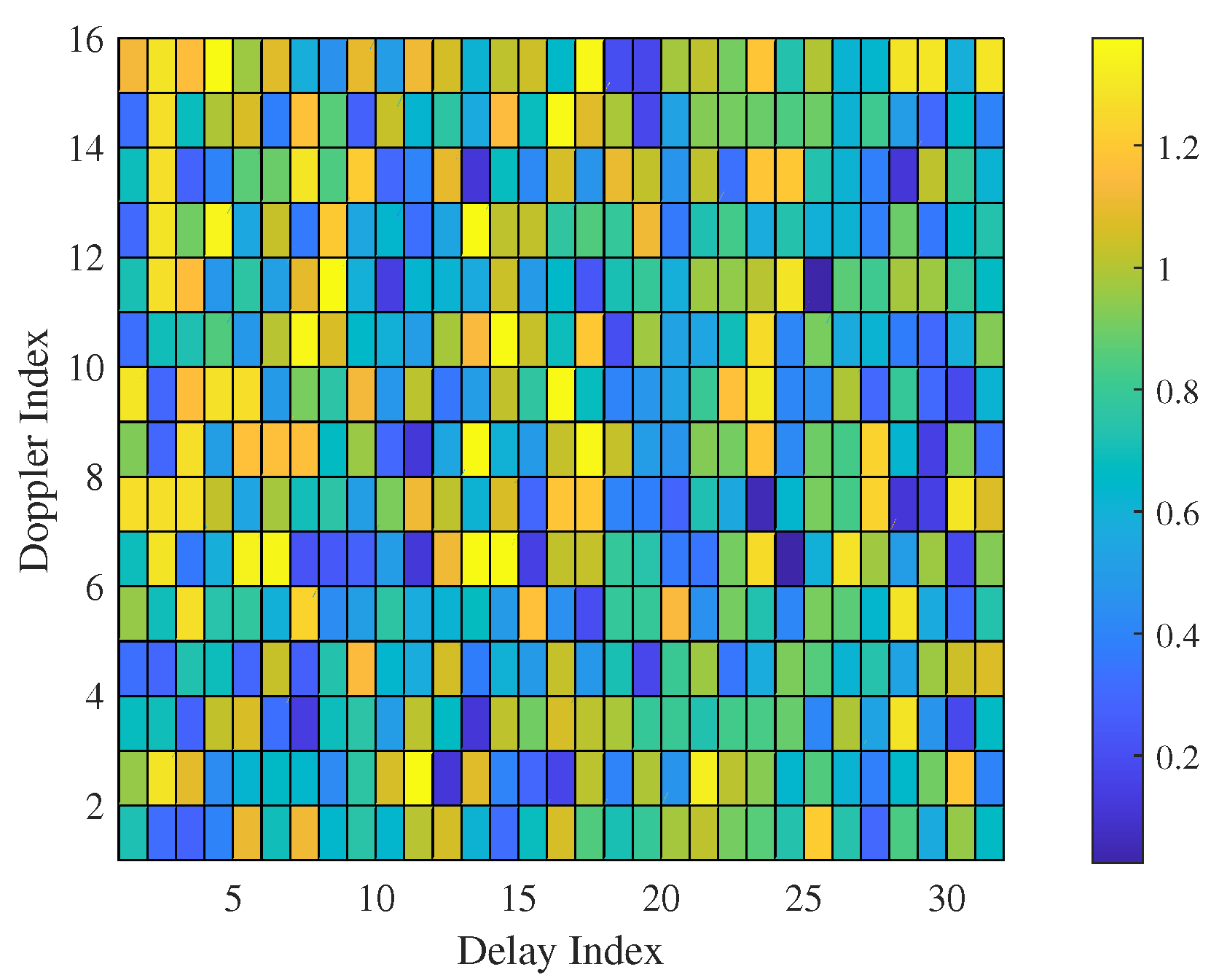
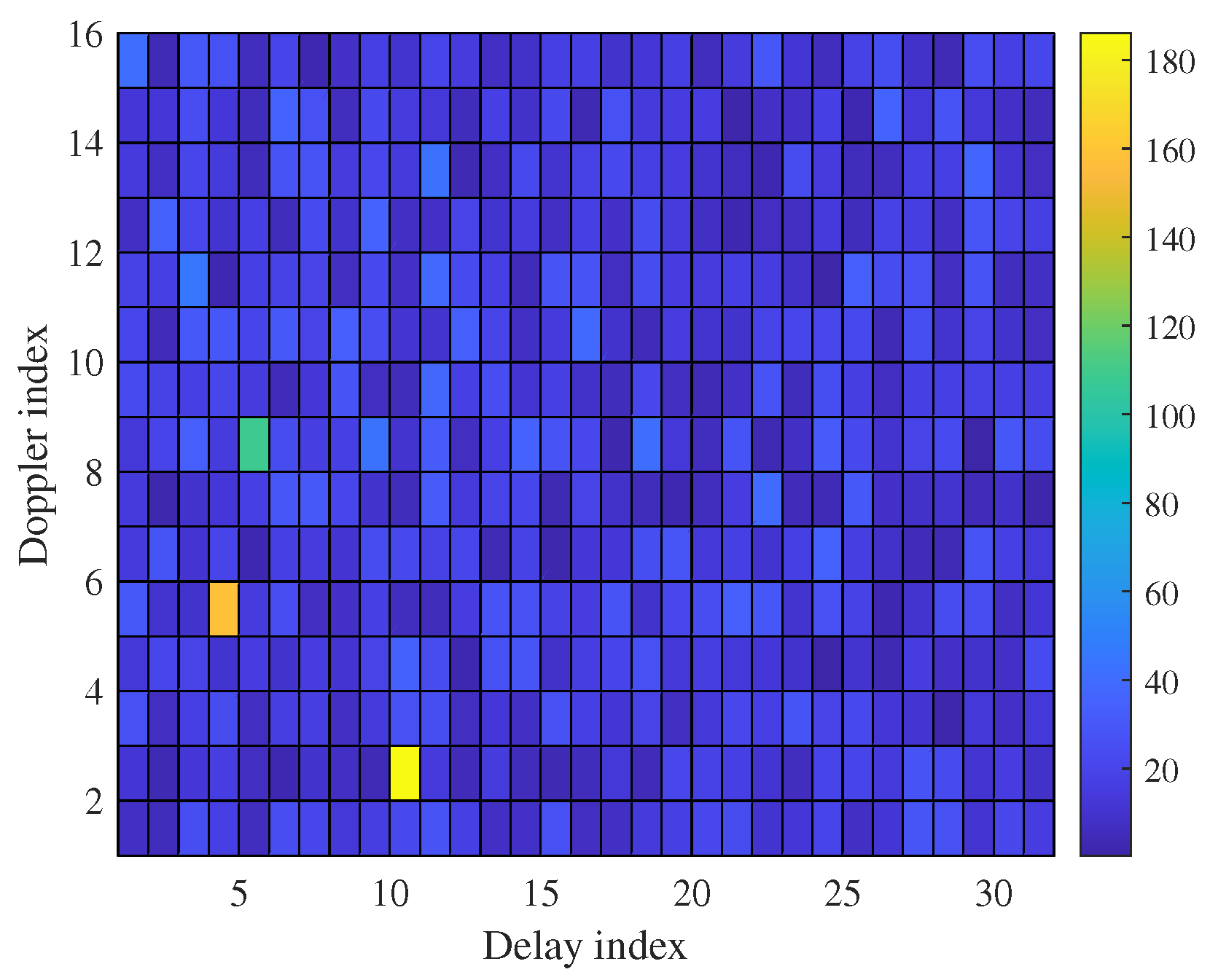
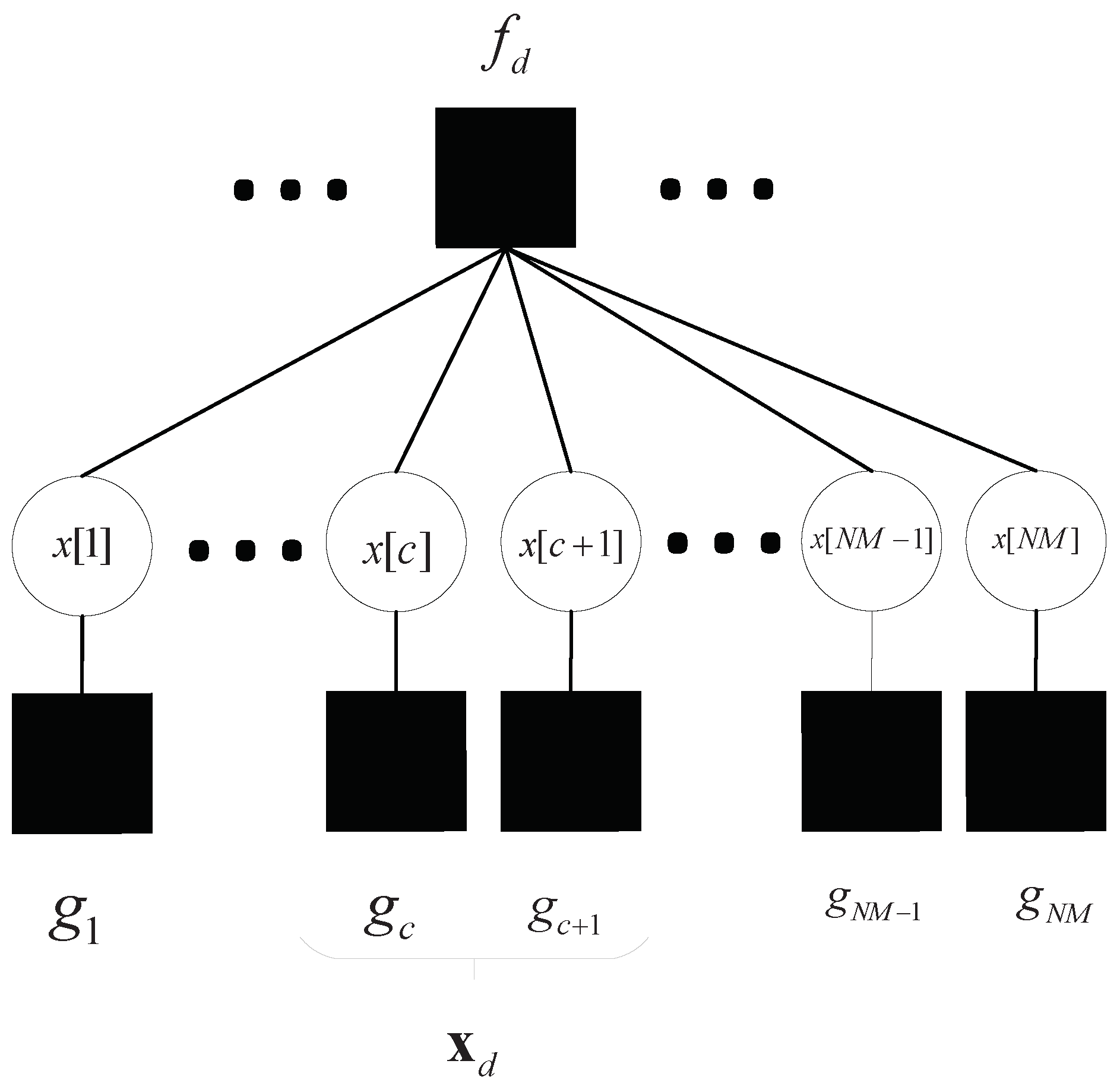
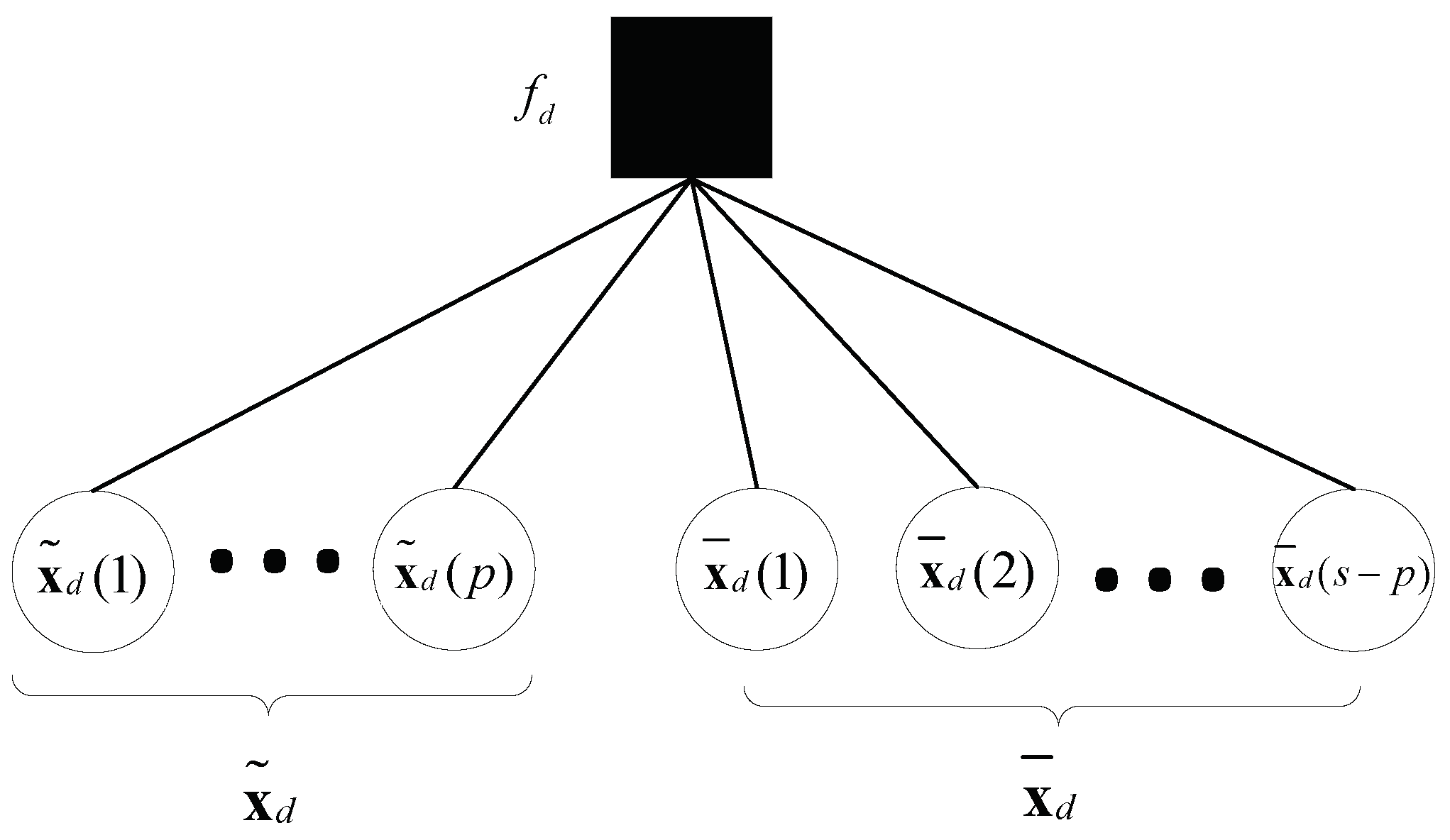

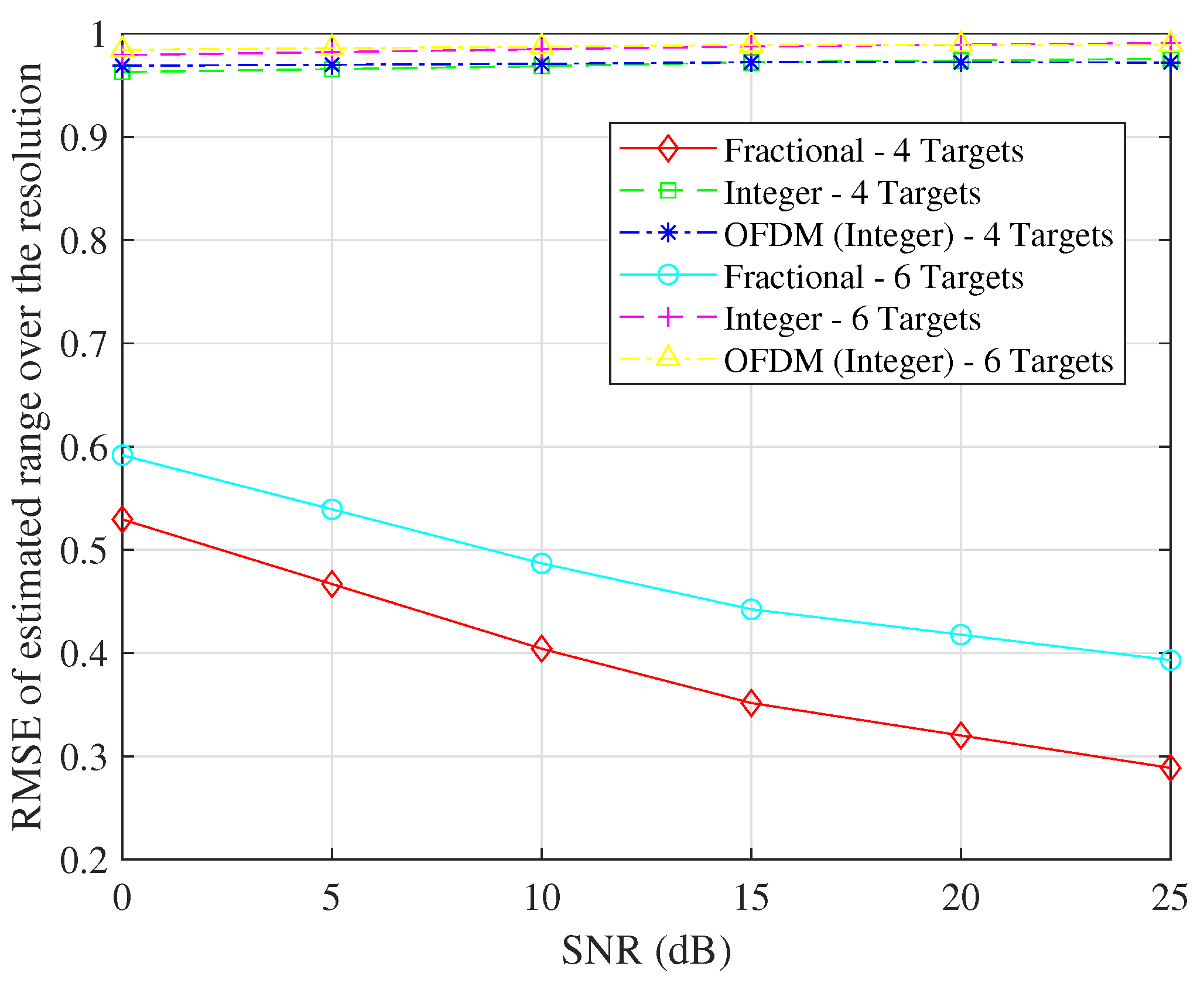



Disclaimer/Publisher’s Note: The statements, opinions and data contained in all publications are solely those of the individual author(s) and contributor(s) and not of MDPI and/or the editor(s). MDPI and/or the editor(s) disclaim responsibility for any injury to people or property resulting from any ideas, methods, instructions or products referred to in the content. |
© 2023 by the authors. Licensee MDPI, Basel, Switzerland. This article is an open access article distributed under the terms and conditions of the Creative Commons Attribution (CC BY) license (https://creativecommons.org/licenses/by/4.0/).
Share and Cite
Zhang, J.; Cai, L.; Liu, H. Integrated Sensing and Communication via Orthogonal Time Frequency Space Signaling with Hybrid Message Passing Detection and Fractional Parameter Estimation. Sensors 2023, 23, 9874. https://doi.org/10.3390/s23249874
Zhang J, Cai L, Liu H. Integrated Sensing and Communication via Orthogonal Time Frequency Space Signaling with Hybrid Message Passing Detection and Fractional Parameter Estimation. Sensors. 2023; 23(24):9874. https://doi.org/10.3390/s23249874
Chicago/Turabian StyleZhang, Ji, Leqi Cai, and Huanyou Liu. 2023. "Integrated Sensing and Communication via Orthogonal Time Frequency Space Signaling with Hybrid Message Passing Detection and Fractional Parameter Estimation" Sensors 23, no. 24: 9874. https://doi.org/10.3390/s23249874





